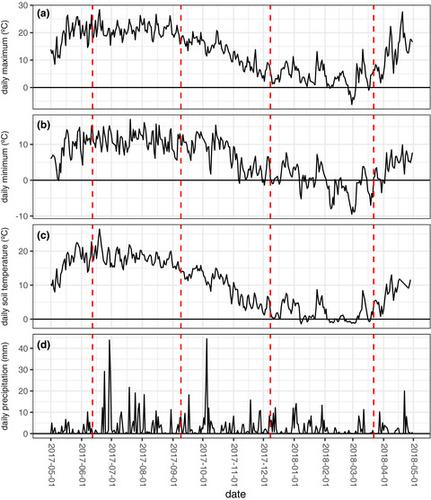当前位置:
X-MOL 学术
›
Ecol. Evol.
›
论文详情
Our official English website, www.x-mol.net, welcomes your
feedback! (Note: you will need to create a separate account there.)
Forest Saccharomyces paradoxus are robust to seasonal biotic and abiotic changes
Ecology and Evolution ( IF 2.3 ) Pub Date : 2021-04-07 , DOI: 10.1002/ece3.7515 Primrose J Boynton 1, 2 , Dominika Wloch-Salamon 3 , Doreen Landermann 2 , Eva H Stukenbrock 2, 4
Ecology and Evolution ( IF 2.3 ) Pub Date : 2021-04-07 , DOI: 10.1002/ece3.7515 Primrose J Boynton 1, 2 , Dominika Wloch-Salamon 3 , Doreen Landermann 2 , Eva H Stukenbrock 2, 4
Affiliation

|
Microorganisms are famous for adapting quickly to new environments. However, most evidence for rapid microbial adaptation comes from laboratory experiments or domesticated environments, and it is unclear how rates of adaptation scale from human-influenced environments to the great diversity of wild microorganisms. We examined potential monthly-scale selective pressures in the model forest yeast Saccharomyces paradoxus. Contrary to expectations of seasonal adaptation, the S. paradoxus population was stable over four seasons in the face of abiotic and biotic environmental changes. While the S. paradoxus population was diverse, including 41 unique genotypes among 192 sampled isolates, there was no correlation between S. paradoxus genotypes and seasonal environments. Consistent with observations from other S. paradoxus populations, the forest population was highly clonal and inbred. This lack of recombination, paired with population stability, implies that selection is not acting on the forest S. paradoxus population on a seasonal timescale. Saccharomyces paradoxus may instead have evolved generalism or phenotypic plasticity with regard to seasonal environmental changes long ago. Similarly, while the forest population included diversity among phenotypes related to intraspecific interference competition, there was no evidence for active coevolution among these phenotypes. At least ten percent of the forest S. paradoxus individuals produced “killer toxins,” which kill sensitive Saccharomyces cells, but the presence of a toxin-producing isolate did not predict resistance to the toxin among nearby isolates. How forest yeasts acclimate to changing environments remains an open question, and future studies should investigate the physiological responses that allow microbial cells to cope with environmental fluctuations in their native habitats.
中文翻译:

森林奇异酵母对季节性生物和非生物变化具有很强的抵抗力
微生物以快速适应新环境而闻名。然而,大多数微生物快速适应的证据来自实验室实验或驯化环境,目前还不清楚从人类影响的环境到野生微生物的巨大多样性的适应率是如何变化的。我们研究了模型森林酵母奇异酵母中潜在的月度选择压力。与季节性适应的预期相反,面对非生物和生物环境变化,奇异链霉菌种群在四个季节中保持稳定。尽管S. paradoxus种群具有多样性,包括 192 个采样分离株中的 41 种独特基因型,但S. paradoxus基因型与季节性环境之间没有相关性。与其他S. paradoxus种群的观察结果一致,森林种群是高度克隆和近交的。这种重组的缺乏与种群稳定性相结合,意味着选择并没有在季节性时间尺度上作用于森林奇异锯齿种群。相反,奇异酵母可能很久以前就进化出了针对季节性环境变化的通用性或表型可塑性。同样,虽然森林种群包括与种内干扰竞争相关的表型多样性,但没有证据表明这些表型之间存在积极的共同进化。森林中至少百分之十的奇异链霉菌个体产生“杀手毒素”,杀死敏感的酵母菌细胞,但产生毒素的分离株的存在并不能预测附近分离株对毒素的抵抗力。 森林酵母如何适应不断变化的环境仍然是一个悬而未决的问题,未来的研究应该调查微生物细胞应对其原生栖息地环境波动的生理反应。
更新日期:2021-04-07
中文翻译:

森林奇异酵母对季节性生物和非生物变化具有很强的抵抗力
微生物以快速适应新环境而闻名。然而,大多数微生物快速适应的证据来自实验室实验或驯化环境,目前还不清楚从人类影响的环境到野生微生物的巨大多样性的适应率是如何变化的。我们研究了模型森林酵母奇异酵母中潜在的月度选择压力。与季节性适应的预期相反,面对非生物和生物环境变化,奇异链霉菌种群在四个季节中保持稳定。尽管S. paradoxus种群具有多样性,包括 192 个采样分离株中的 41 种独特基因型,但S. paradoxus基因型与季节性环境之间没有相关性。与其他S. paradoxus种群的观察结果一致,森林种群是高度克隆和近交的。这种重组的缺乏与种群稳定性相结合,意味着选择并没有在季节性时间尺度上作用于森林奇异锯齿种群。相反,奇异酵母可能很久以前就进化出了针对季节性环境变化的通用性或表型可塑性。同样,虽然森林种群包括与种内干扰竞争相关的表型多样性,但没有证据表明这些表型之间存在积极的共同进化。森林中至少百分之十的奇异链霉菌个体产生“杀手毒素”,杀死敏感的酵母菌细胞,但产生毒素的分离株的存在并不能预测附近分离株对毒素的抵抗力。 森林酵母如何适应不断变化的环境仍然是一个悬而未决的问题,未来的研究应该调查微生物细胞应对其原生栖息地环境波动的生理反应。











































 京公网安备 11010802027423号
京公网安备 11010802027423号